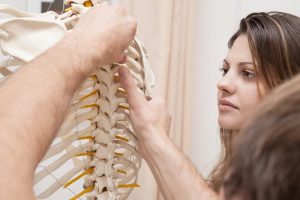
About Thoracic Spine Pain
The Thoracic spine is the region of the back between the shoulder blades. There are 12 vertebrae that make up the thoracic spine and there are 12 sets of ribs that attach to those 12 vertebrae on each side.
The most common cause of thoracic spine pain is musculature or soft tissue. Poor posture, sitting too long (leads to muscle fatigue) and trauma (such as whiplash from a motor vehicle accident or a sports injury) are the most common causes of thoracic spine pain. It is the least frequent region of the spine to have a herniated/bulged disc.
Treatment may vary depending on the diagnosis. Treatment may include chiropractic adjustments, acupuncture, massage therapy and possibly physical therapy. X-rays or other diagnostic tests may be necessary to determine the best care for your condition. Proper posture and movement as instructed by your chiropractor can help prevent recurrences.
The Doctors of Chiropractic at ADIO Chiropractic Center can help you determine what is causing your pain and the best steps to alleviate your symptoms.
Thoracic Disk Bulge
Situation: Costovertebral Joint Sprain occurs when there is damage to the joints connecting your ribs to the vertebrae of your upper—or thoracic—spine. Along with the facet joints, the costovertebral joints are designed to support your body weight and allow movement like bending, twisting, lifting, and arching. Each costovertebral joint is made up of smooth cartilage which lies between the bony surfaces, cushioning the impact of one bone—your rib—on another—your vertebrae. Strong connective tissue also wraps around the bony ends, providing support to the joint. When excessive stretching or compressive forces are placed on the costovertebral joints, damage to the cartilage, misalignment of the rib head or tearing of the connective tissue surrounding the joint can occur. This injury is a known as a costovertebral joint sprain.
Causes: Costovertebral joint sprains typically occur during excessive bending, lifting, arching, or twisting movements, although they are sometimes also caused by trauma—like sports injuries or car accidents—or repetitive movements. Symptoms: Symptoms can include sudden pain in the upper back and rib while actively bending, twisting, lifting, and arching. Sometimes, however, pain and stiffness occur after the activity, often the next morning. Symptoms are generally felt on one side of the spine and rib cage, frequently with accompanying muscle spasms around the injured joint.
Treatment: Treatments options can include chiropractic care, acupuncture, physical therapy, and massage therapy. The chiropractor will help determine what type of treatments and modalities are appropriate for you.
Thoracic Outlet Syndrome (TOS)
Situation: Thoracic Outlet Syndrome—also called T-O-S—is a compression of the nerve and blood vessels as they pass from the neck to the arms. There are three types of thoracic outlet syndrome. Each type of TOS is named for the structures involved.
Types:
The T-O-S condition is known as scalene syndrome refers to the scalene, are a group if muscles in the neck that can compress the nerves and blood vessels as they pass from the neck to the shoulders.
The T-O-S condition classified as costo(rib) clavicular (collarbone) syndrome involves the compression of the blood vessels and nerves between the collarbone and first rib of the ribcage due to misalignment.
The T-O-S condition labeled pectoralis minor syndrome refers to the compression of blood and nerves under the pectoralis—or chest—muscle.
Symptoms: Symptoms from any T-O-S condition can cause pain, tingling, numbness or weakness into the shoulders, arms, and hands. The symptoms are mostly seen at night when compression of the shoulder is common. It is common with T-O-S to wake up with dead arm sensation. Initially symptoms will be intermittent and self-resolving. Thoracic outlet syndrome is often misdiagnosed as carpal tunnel syndrome.
Treatment: Treatments options can include chiropractic care, acupuncture, physical therapy, and massage therapy. Your chiropractor will be able to promptly and accurately diagnose which form of TOS you are suffering from and begin the correct course of treatment.
